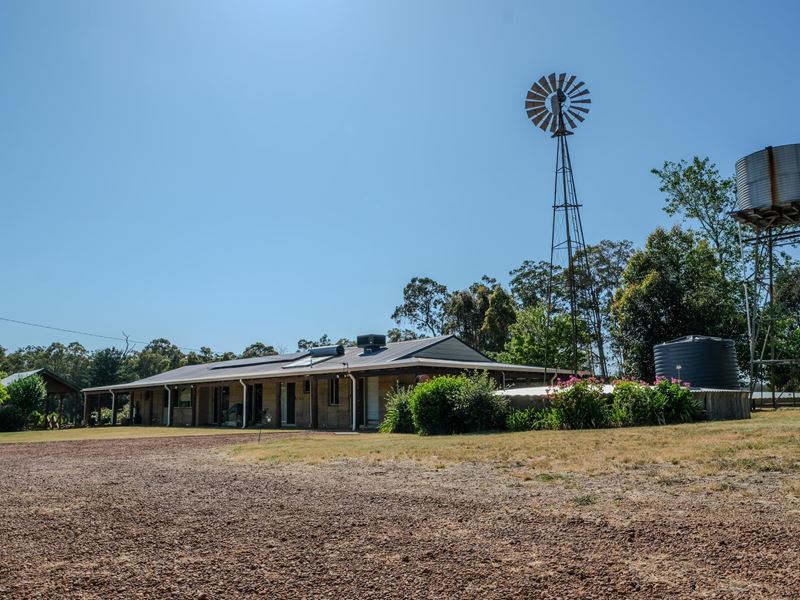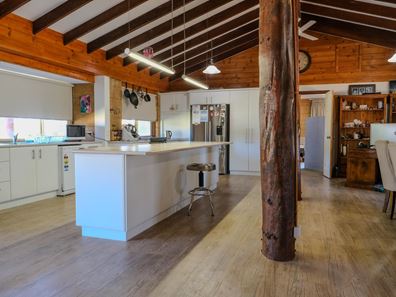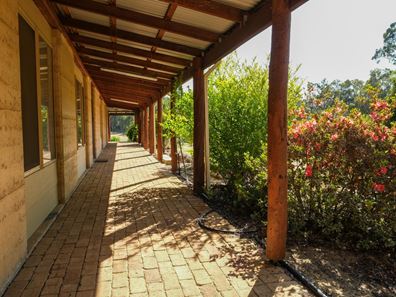Rammed earth 4-bed home on 13 acres, plus 2 cottages to AIRBNB and a business thrown in.
This magnificent 13 acre property is bordered by forest, has a an abundance of natural spring water, first property on the line for natural spring which has provided an endless supply of water for 20 years.
Large shed with the infrastructure to supply colloidal silver "trade marked" product to an Australia wide distributor, netting the the property owners a six figure sum per annum for five days work per month. [figures available]
in addition, there are two cottages on the property, perfect to AIRBNB or rent out to garner even more cashflow.
While the main home was built in approximately 1990, its rammed earth and iron, exposed beam construction offers a timeless aesthetic, normally associated with much newer builds.
MAIN HOME
- Air-conditioned
- Pot belly stove
- Large kitchen and oven
- Solar 9 panels 2.5 kva
- 4 bedroom
- 2 bathroom
- Large open plan kitchen/dining/living rooms
- Office
- Car port for 2 vehicles
- Rain water tanks 2 x 80000 litres
- Spring water tanks 2 x 9000 litres
- Roof installed 2014
- Hot water system 5 years old
- Fisher & Paykel Stainless Steel Refrigerator
- Assorted household furniture included
COTTAGE NO.1
- 2 bedroom
- 1 bathroom
- Kitchen
- Lounge
- Office
- 4 bay car port
- Spring water tank x 2700 litres
- Metters wood-fired stove
- Electric hot water system
COTTAGE NO.2
- 1 bedroom
- 1 bathroom
- Kitchen
- Lounge
- Spring water tank x 1000 litres
- 4,500 rainwater tank (not connected)
- upright gas stove and oven
- electric hot water system
ASSORTED
- Fruit trees -
- Including orange lemon fig mulberry olive
- Chickens and Omlet chicken coup and run
- 2 x raised garden beds
LARGE SHED [Insulated] includes;
- Laboratory [uninsulated] - produces colloidal silver - water sanitizer
- Purification RO machine
- Dexion framing
- Steel office cabinet
- 2 x desktop computers
- 1 x laptop
- 1 x scanner
- 1 x Brother printer
- 1 x Zebra label printer
- 2 years of bottles, caps and packaging
- 2 x 4,500 rain water tanks
- Fisher & Paykel Upright freezer
- Fisher & Paykel Refridgerator
- Fisher & Paykel 275L chest freezer
- LG 8kg top loader washing machine
WOODEN SHED
- Large assortment of power tools
- Including Makita corded and cordless drills
- Mini jackhammer, circular saws
- 2 x arc welders + helmet
- Extra Dexion framing
ADITIONAL EQUIPMENT EXTRAS
- ISUZU D-Max Utility
- Kuboto tractor L3800
- plough and slasher attachments
- Crown forklift (on gas)
- ride on Cox Mower with Honda Motor
- self-propelled Deutsche slasher with Honda Motor
- Masport 550 EX lawn mower
- 1 x 20' shipping containers with checkerboard flooring
- 1 x 20' shipping containers with timber flooring
- fire unit with hose for spot fires with Honda Motor
- trailer x 8 x 4 [fits 2 x chep pallets]
- 100l mobile spray unit with boom
Property features
-
Carports 6
Property snapshot by reiwa.com
This property at 2111 Pinjarra-Williams Road, Dwellingup is a four bedroom, two bathroom house sold by Dino Brescacin at Acton | Belle Property Dalkeith on 31 Oct 2023.
Looking to buy a similar property in the area? View other four bedroom properties for sale in Dwellingup or see other recently sold properties in Dwellingup.
Cost breakdown
-
Council rates: $1,682 / year
Nearby schools
Dwellingup overview
Dwellingup is located in a timber and fruitgrowing area in the Darling Range ESE of Pinjarra. Townsite lots were surveyed at this place by Surveyor W.F. Rudall in 1909 after the Lands Department became aware that the site was planned as the terminus of the "Pinjarra-Marrinup Railway". Names suggested for the place by Rudall were "Dwellingerup" or "Marrinup", after nearby brooks, or "McLarty" after a local MLA who had been very active concerning the railway. Surveyor General H.F. Johnston chose "Dwellingupp" after being misinformed regarding the spelling of Dwellingerup Brook. Ignoring a suggestion from the Under Secretary to amend the name to "Dwellingdown", the Minister for Lands approved the name as "Dwellingup" in December 1909. Eventually, the spelling "Dwellingupp" was chosen by order of the Under Secretary for Lands, and the townsite was gazetted as Dwellingupp in February 1910. The spelling was amended to Dwellingup in 1915. Dwellingup is an Aboriginal name said to mean "place of nearby water". The town was burnt out by a bushfire in 1961 but was rebuilt.
The double 'p' spelling in the original gazettal of this name was used because the Lands and Surveys Department had adopted a system for spelling Aboriginal names developed by the Royal Geographical Society. A number of Aboriginal names ending in "up" were for a time spelt with the "upp" ending (including Kirupp, Kulikupp, Manjimupp and Mungalupp). The RGS system had a rule that vowels are pronounced as in Italian and consonants as in English. This would have meant that names ending in "up" should have been pronounced as "oop", because the Italian "u" was a long "u", as in flute. These Aboriginal names were meant to be pronounced as "up", and the Department asked the RGS for a rule to assist in correct pronunciation. The RGS solution was that doubling the following consonant shortened the preceding vowel, and this meant the "upp" ending ensured the "up" pronunciation. However, this particular rule was rescinded in 1915 for SW towns with the suffix "up", as the Australian way of pronouncing the letter "u" was almost always short, and rarely the Italian "oo".
Dwellingup quick stats
Contact the agent
Mortgage calculator
Your approximate repayments would be





